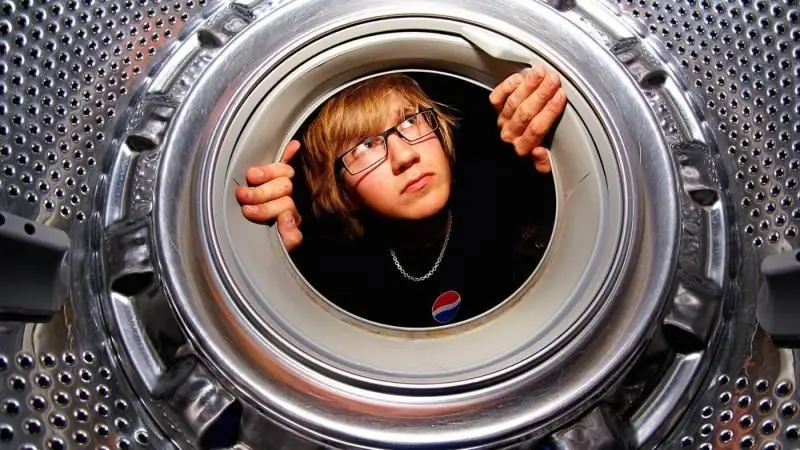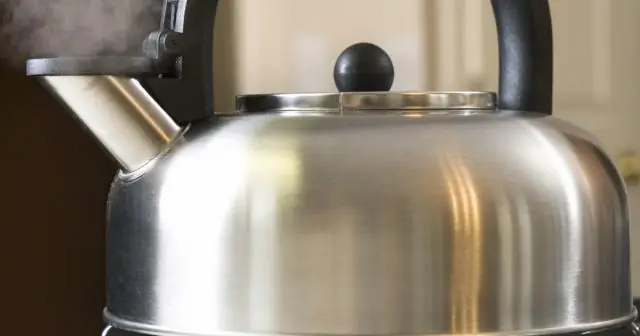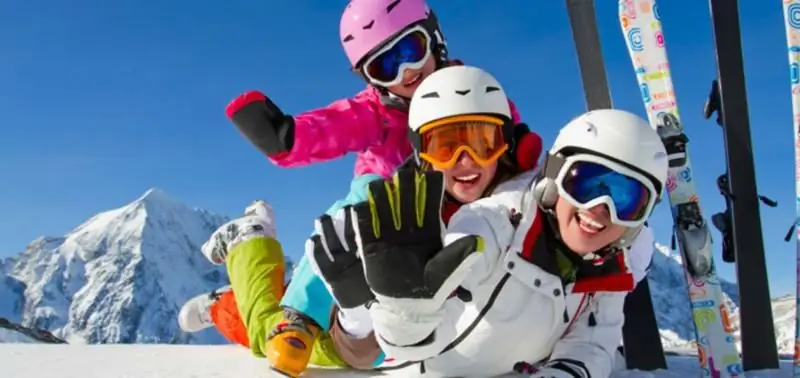
Table of contents:
- Author Bailey Albertson [email protected].
- Public 2023-12-17 12:53.
- Last modified 2025-06-01 07:32.
How to quickly clean a washing machine from dirt and odor

The person who invented the automatic washing machine needs to erect a monument in every locality. Surely any hostess will agree with this. This household device made our life so much easier that we recall those times when we washed things by hand, like a bad dream. But still, troubles do occur, bringing a fly in the ointment into the ointment. For example, a washing machine, even almost new, gets dirty inside and out, giving off unpleasant odors. All this spoils the appearance of the device and affects the washed things. It is urgent to get rid of this scourge, especially since there are a lot of ways to clean the surfaces!
Content
- 1 Causes of dirt and odor in the washing machine
-
2 How to clean the inside of the car: step by step instructions
- 2.1 Video: cleaning the washing machine with household chemicals
- 2.2 Cleaning the drum and heating element
- 2.3 Video: how to descale a washing machine
- 2.4 Cleaning the sealing gum (cuff)
- 2.5 Cleaning the powder and detergent dispenser
- 2.6 Cleaning the drain pump
- 2.7 Cleaning the water inlet filter
- 2.8 Video tutorial: how to clean the inlet hose filter
-
3 Learning how to properly remove various dirt
- 3.1 How to remove sludge, slag and dirt from the drum
- 3.2 Cleaning rust
- 3.3 Getting rid of unpleasant odors
- 3.4 Removing mold and mildew
- 3.5 Disinfecting the inside of the washing machine
- 3.6 How to brush animal hair
The causes of dirt and odor in the washing machine
Even if your family consists of you and your pet, you have to do the laundry at least once a week. Imagine how many times and how much you have to wash those who have children? And then one day you open the washing machine and you notice dirt spots on the interior surfaces. There is also a damp smell coming from the drum.
It would seem, where do they come from? Indeed, during the operation of the machine, running water circulates in the drum, which should take away with it without a trace all the dirt and residues of funds. It turns out that the dirt formed when washing things remains inside the machine, and there are many reasons for this.
-
The tap water used for washing contains many chemical elements, including iron, which affects its hardness. When exposed to high temperatures, these substances concentrate and settle on hard surfaces in the form of limescale.

Limescale on the heating element Mineral substances contained in tap water are deposited on the heating element of the washing machine in the form of scale
- Most often, a gentle wash at 40 ° C is used. This temperature is not high enough to break down fats and completely dissolve impurities. Dirt washed off from things remains in the drain hose, filter and seal; decomposing, over time it becomes the cause of odors.
- Powders, bleaches, rinses, and other products do not always dissolve completely in water. Most often, they are the ones that settle in the rubber seal, forming fungus and mold under the influence of moisture. They, in turn, give off an unpleasant odor and damage clothing.
-
We often use more powder and detergents, mistakenly thinking that this will improve the washing result. In fact, the surplus will simply settle to the bottom of the drum and accumulate there, eventually overgrowing with mold and mildew due to moisture.

Washing powder Use just as much detergent as needed according to the instructions: excess detergent may remain in the machine and cause mold to develop
-
Many things that are intended for washing are put into the drum of the machine until a sufficient amount has accumulated. Dirty clothes, even dry ones, can become a source of unpleasant odors. And if, after washing, you do not take out the laundry from the drum, leaving it at least overnight, it will start to smell bad due to moisture and may become covered with fungus or mold.

Towels in the washing machine Remove laundry from the machine immediately after washing to avoid mold and unpleasant odors
- Sand and rust from the water pipe are deposited on the filter in the inlet hose. The drain pump filter collects on itself not only the washed away dirt, but also every little thing from your pockets: threads, debris, pieces of paper, pins and even coins. Over time, this can cause the machine to break down, and you will find dirt on things and an unpleasant smell very quickly.
As a result, the washing machine ceases to be your indispensable assistant in everyday life, but instead brings additional hassle. To avoid this, it is worth learning how to take care of the device and clean it properly.
How to clean the inside of your car: step by step instructions
As with any business, consistency is important in cleaning a washing machine. It is worth carrying out a complete processing of the device, and not of some of its individual nodes; otherwise, the remaining dirt will nullify all efforts. You will have to clean up:
- drum;
- Heating element;
- drum cuff;
- tray for powder and detergents;
- drain pump and water inlet filters
- body and door.
Surfaces can be treated with special chemicals or available folk remedies that are in every home: vinegar, soda, etc.

There are special cleaning products for washing machines that will make your job much easier.
Video: cleaning the washing machine with household chemicals
Drum and heating element cleaning
First of all, you need to get rid of the scale, which has firmly settled on the drum and heating element. Since mineral deposits are composed primarily of calcium and magnesium salts, organic and inorganic acids are the best means of breaking them down. Hydrochloric acid or sulfuric acid will do an excellent job of this problem, but their corrosive effects can damage the surfaces to be cleaned. But you probably have citric acid or vinegar at home, which last longer, but are safer.
For the first cleaning method, you will need:
- 2 cups 9% table vinegar (you can take alcohol white vinegar in the same amount);
- ¼ a glass of water;
- ¼ glasses of baking soda;
- hard sponge.

Vinegar and baking soda are cheap but very effective descaler
In a bowl, combine the water and baking soda and transfer the mixture to the detergent tray. Pour the vinegar directly into the drum. Set the setting with the highest temperature and the longest setting. Start an empty car and wait for the work to finish.
The second way is even easier. You will need several packs of citric acid (from 1 to 6, depending on the dirtiness of the machine and its volume). Pour the detergent into the detergent dispenser and run the empty machine on the hottest setting for the longest wash time.

You can easily remove limescale and dirt with citric acid
You can also use the Anti-Scale, which can be bought at any household chemical store. The aggressive substances that make up its composition dissolve well magnesium and calcium salts, which form a limescale, during decomposition.
Video: how to descale a washing machine
Cleaning the sealing gum (cuff)
After the machine has finished the cleaning cycle, start washing the cuff. The work is difficult and painstaking: this hard-to-reach place collects not only dirt, but also moisture, which provokes the formation of mold.
Any powder detergent will be good helpers in cleaning the cuff: soda, Pemolux. A large amount of mold, especially if an unpleasant odor is already emanating from it, will get rid of more powerful substances:
- White;
- Comets;
- Dressing Duck;
- Domestos.
All of these products contain chlorine, so do not use them too often so that the rubber of the cuff does not deform.

Chlorine powders are corrosive enough to rubber that you don't need to use them too often to clean the seal.
- Take a damp sponge and apply a small amount of the chosen substance to it. Pull the rubber on the cuff slightly. Thoroughly dry the metal surface of the housing and the rubber of the seal.
-
Dirt most often accumulates in the lower part of the hatch when it comes to a horizontal loading machine. It is this section of the circle that you will have to clean and wipe with special care, but you should not forget the rest of the surface. The top loader seal is equally contaminated around the perimeter.

Dirt under the seal Most often, dirt accumulates in the lower part of the washing machine door.
-
The most difficult to reach parts of the cuff are easy to clean with a toothbrush; you don't have to pull the rubber too hard to reach the dirt with a rag or sponge.

Cleaning the seal with a toothbrush With a toothbrush, you can easily clean the rubber cuff
- After cleaning is complete, wipe the seal first with a damp and then with a dry cloth.
Cleaning the powder and detergent drawer
It is recommended to wash the tray every 2-3 washes, so that later you do not have to pierce the channels and soak the powder adhering to the walls. To do this, remove the tray completely from the device. The extraction scheme is usually standard:
-
On a horizontal loading machine, pull out the tray until it stops, slightly lift the edge of the tray, and then pull it up towards you. Many models have latches with markings on the sides to show you how and in which direction to press.

Laundry detergent tray To clean the washing powder tray well, it must be completely removed from the machine.
- In vertical machines, there are 2 types of trays fixing. In the first case, the tray is attached to the lid with 2-3 latches, which must be unfastened and the container pulled towards you. The second option is that the tray is built into the drum on the side of the window, and you will have to wash it on the spot.
When you take out the tray, you will see powder residues in its compartment. Put some dish detergent on the hard side of the sponge and carefully wipe the surfaces of the tray. To clean it from the inside, you can use a toothbrush or brush. After that, rinse the tray well on all sides under plenty of running water to dislodge any remaining powder from all the tubules.
If the container is too dirty, and traces of rust are visible on it, you will have to work longer. Place the tray in a bowl of suitable size and fill completely with hot water. For greater efficiency, you can add 1-2 tbsp. l. soda and about 100 g of vinegar. Leave to soak for a while (30 minutes to 2 hours, depending on the degree of soiling). You can also moisten the tray with water and cover it with a cleaning powder, such as Pemolux, and also leave it on for a while. After that, clean the container from all sides with a hard sponge or toothbrush, rinse thoroughly, wipe dry.

Soak the tray in water for a while to make it easier to clean
The tray can be washed in a dishwasher. It will not completely remove the rust, but it will make it much more susceptible to subsequent cleaning.
But it will be difficult to clean the powder receptacle compartment: there are many protruding parts and hard-to-reach indentations on which rust can form. Spray the walls with liquid cleaner and let soak for 2 hours. Then clean off the dirt and rust with a hard sponge.

There are many hard-to-reach places in the powder compartment, so cleaning it won't be easy
Cleaning the drain pump
When the water is drained from the tank, the lion's share of the dirt settles on the filter of the drain pump. Over time, it can completely clog, not letting out water and driving it up. Therefore, do not forget to clean the filter, especially since it is not difficult at all. You will need:
- rag or towel;
- a container suitable for the volume (for example, a baking sheet for the oven);
- flat screwdriver.
If you don't have a screwdriver on hand, use a flat, hard object such as a nail file.
-
Access to the filter is located at the bottom of the machine body. Most often it is covered with a small panel.

Front panel of the washing machine The access to the drain filter is usually covered by a panel
-
You can easily open this panel by prying slightly with a screwdriver.

Open drain filter You can remove the panel by prying it with a screwdriver
-
This is a closed filter. First of all, place a towel under the drain and place a dish to collect water (it can pour out about 0.5 liters). If there is not enough water, it is enough to do with a towel: turn it over as it gets wet, first covering and opening the lid.

Draining water from the washing machine filter Place a towel under the clipper or place a drip tray to prevent water spilling out on the floor
-
When all the water is drained, you need to unscrew the lid counterclockwise and clean out the accumulated dirt.

Disassembled water drain filter Take out the filter and remove all dirt
- Wipe the drain hole thoroughly, first with a damp cloth and then with a dry cloth. Close, put back the decorative panel.
Cleaning the water inlet filter
The next step in cleaning the inside of the machine is the inlet hose filter, which is often clogged with sand and rust particles. Such pollution leads to the impossibility of collecting water, which makes the machine stop washing. The filter in the inlet hose can be cleaned no more than once every 6 months. To do this, you need pliers (you can use pliers) and a toothbrush.
- First of all, be sure to shut off the cold water access to the machine.
- Then turn the machine back to you. The inlet hose is located on the right side of the housing, at the top.
-
The hose nut must be unscrewed counterclockwise. Inside the hole you will find a small filter with a mesh. You need to get it out with pliers.

Water inlet filter Unscrew the hose nut and remove the filter with pliers
- Immerse the filter in water and brush it out with a toothbrush.
- Put the filter back in place, twist the hose clockwise as tight as possible.
- Open the tap for water access to the machine, then wipe the back wall and unfold the machine, putting it in its usual place.
After you are done cleaning the inside of the washing machine, all that remains is to wash the door, sides and top with soapy water, clean the protruding buttons on the control panel, and wipe everything dry.
Video tutorial: how to clean the inlet hose filter
Learning how to properly remove various dirt
Above, we have already talked about how to get rid of the most common trouble in the washing machine - scale. But there are more complicated things: silt, slag, rust, mold and mildew already formed, and even animal hair. It may be necessary to eliminate the odor and even disinfect the inside of the machine.
How to remove sludge, slag and dirt from a drum
There are many hard-to-reach places in the drum, for example, overhead ribs fixed around its circumference. It is inside them that layers of dirt, silt and slag settle, these parts are removable, they must be unfastened as indicated in the instructions for the washing machine and cleaned by hand.

Dirt and sludge can accumulate in the removable parts of the machine
If you have a large saucepan, put the removed parts of the machine in it, fill with water, add 1 tbsp. l. citric acid and 2-3 tbsp. l. table salt and boil for 15 minutes. This will help remove most of the dirt. Then rinse the parts in running water, wiping off the remaining dirt with a sponge. Stubborn stains can be wiped off with a mild hydrochloric acid solution.
Rust cleaning
Moisture is the cause of rust on the metal surfaces of the machine. Most often, it is concentrated in hard-to-reach places at the joints of parts, especially on the back of the device. If the washing machine is in the bathroom, then exposure to high humidity is common.

The higher the humidity in the room where the washing machine is located, the faster you will find rust on the surfaces of the device.
If you find rust streaks, get down to business as soon as possible using one of the tips below.
-
Buy a specialty rust and stubborn stain remover from your local hardware store. Apply it directly to the rust stains and let it sit for 10-20 minutes, then wipe it off with a damp cloth.

Household detergents Use chemical detergents to remove rust and stubborn dirt
- If you find small rusty spots, use a mixture of vinegar and lemon juice in equal proportions. Apply it to dirty areas, leave it on for an hour or a little longer. Clean with a brush and rinse with warm water, wipe dry with a cloth. Repeat the procedure if necessary.
-
For more visible stains, you will need baking soda, which has a harsher effect. Stir the soda in a little water to make a gruel. Apply it to the area with the rust stain, leave it on for 15-20 minutes. Wipe off dirt with the hard side of a washcloth or a metal scraper. If the rust is old, the procedure must be repeated 1-2 more times.

Vinegar, citric acid and soda Vinegar, citric acid, and baking soda are great at removing rust marks
-
You've probably heard that popular carbonated drinks (Coca-Cola, Pepsi, Fanta) eat rust well. This is due to the effect of phosphoric acid in their composition. Soak a cotton swab well in soda. Apply to the contaminated area for 10-15 minutes. You may need to repeat the procedure. Small removable parts with traces of rust can be completely immersed in the drink for half an hour. Be sure to wipe dry the treated areas.

Sprite, Coca-Cola and Fanta Popular carbonated drinks do well with rust thanks to their phosphoric acid content.
Getting rid of unpleasant odors
Over time, rotten or sour smells begin to come from the car. The reason for their appearance is cheap and low-quality detergents, from which a thin soap layer remains on the inner surface of the drum. Over time, it decomposes and becomes a good breeding ground for the fungus.

An unpleasant odor occurs due to poor-quality detergents that leave a soapy residue inside the washing machine.
Dealing with the problem is not difficult:
- using an automatic powder wash with an empty drum at the maximum temperature;
- after each wash, wipe the door and drum dry, leave the machine open for airing;
- carry out prophylaxis every six months.
It is worse if the odors are the result of mold formation that can harm your health. You need to deal with it separately.
Removing mold and mildew
The more often you use the gentle wash, the more likely it is that mold will develop in the machine. The main places of its deployment:
- compartment for powder and detergents;
- drain hose;
- gum seal.

Mold most often appears in the powder compartment, drain hose and under the rubber band of the seal
To remove mold from these areas, clean them with a brush rubbed with laundry soap, then rinse with water and wipe dry.
If mold has formed in the drum, apply whiteness. Pour 1 liter of detergent into the tray, set the temperature to 90 ° C, start the wash with an empty drum. If the door gets warm, pause the machine for 1.5 hours. Then resume your work. When the wash is over, pour vinegar into the fabric softener compartment and rinse.

Whiteness is a cheap product that will perfectly remove all traces of mold.
Found a fungus in the car? Regular soda will help get rid of it.
- Mix baking soda with water in a 1: 1 ratio.
- Soak a cloth in this solution, thoroughly wipe all affected surfaces: seals, drum, tray.
- Rinse the treated surfaces well.
Copper sulfate, which was widely used for this purpose by our grandmothers, helps well against mold and mildew. Dissolve 30 g of vitriol in 1 liter of water.

Our grandmothers also used a solution of copper sulfate to get rid of mold and mildew
Wipe the inner surfaces of the machine with the solution and leave for a day. Then start washing with normal powder.
Disinfection of the washing machine from the inside
To remove fungus, bacteria, unpleasant odors and mold at the same time, you need to disinfect. To do this, you need to prepare a mixture of 1 part chlorine bleach and 2 parts active detergent powder. Place this mixture in the tray and drum, and run the machine with no load, setting the temperature to 60 ° C. For better disinfection, set the maximum temperature, but in this case, the entire mixture must be placed in a drum.
How to brush animal hair
If you have four-legged pets at home, then their fur will inevitably stick to all items of clothing. Brushing things before washing does not always help, and as a result, hairs settle inside the machine.

Pet hair can cause poor washing machine performance
First of all, the pressure switch, or, in a simple way, the water level sensor suffers from this. Over time, the wool clogs his pipe, which can cause 2 problems:
- the sensor does not give a signal that the tank needs to be filled with water;
- the machine does not spin.
To eliminate this problem, disconnect the rubber tube from the pressure switch and manually remove wool and other debris.
Another part of the washing machine that gets clogged with wool is the drain pump filter. Contamination gets into it when the water is drained. Because of this, the spin mode jams, and the water after washing does not pour out of the machine. To avoid such a nuisance, clean the pump filter at least once every 2 months.
Some models of washing machines have a built-in function to remove animal hair from clothes. As a rule, it includes a gentle wash and an extra rinse, which are standard on all other models. If your machine does not have this function, just turn on the rinse mode 2 times. And do not forget to pre-brush things before washing.
Do not forget that your washing machine is an irreplaceable assistant in everyday life, which means that you need to take care of its condition mutually. As you can see, this is not difficult at all. All you have to do is follow our advice, removing dirt in a timely manner, so that the machine will serve you for as long as possible without interruptions.
Recommended:
How To Clean An Electric Oven Outside And Inside From Carbon Deposits And Grease: Catalytic And Other Types Of Cleaning + Video

How to clean an electric oven from dirt and carbon deposits inside and out: using chemistry, folk remedies and self-cleaning technologies
How To Clean A Burnt Stainless Steel Pan, How To Clean Inside And Outside At Home

Information on how to clean a stainless steel pot using available tools. Traditional methods of getting rid of soot, fat, burnt food, water stains
The Washing Machine Does Not Drain Water - Why And What To Do In This Situation, Features Of Repairing Samsung, Indesit, LG And Other Companies, As Well As User Reviews

What to do if the washing machine does not drain water: solutions to the problem, features of repairing different models. Instructions with photos and videos
How And What To Wash Membrane Clothes, Is It Possible To Use A Washing Machine, What Powder Is Needed And Other Nuances Of Cleaning

Features of membrane fabric, how to properly wash clothes from it, cleaning products, as well as tips with a video on the care of high-tech material
How To Get Rid Of Mold In A Washing Machine: Effective Cleaning Agents Inside And Out

Means and methods of getting rid of mold in a washing machine, both on the outside and inside. Preventive measures
